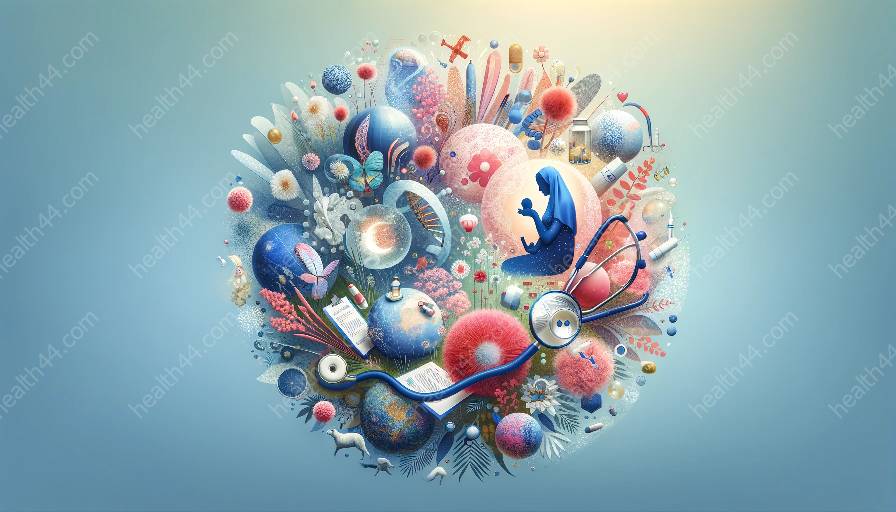The male reproductive system is a complex and vital part of human anatomy. Understanding its anatomy and physiology is crucial in the context of infertility and its interactions with obstetrics and gynecology.
Male Reproductive Anatomy
The male reproductive system consists of several organs that work together to create, store, and transport sperm. The primary organs include the testes, epididymis, vas deferens, seminal vesicles, prostate gland, and the penis.
Testes
The testes are the male gonads responsible for producing sperm and the male sex hormone, testosterone. Each testis is an ovoid structure suspended outside the body in the scrotum. Sperm production occurs within the seminiferous tubules, which are tightly coiled structures within the testes.
Epididymis
The epididymis is a coiled tube located on the back side of each testis. Its primary function is to store and transport sperm from the testes to the vas deferens.
Vas Deferens
The vas deferens, also known as the ductus deferens, is a muscular tube that transports mature sperm from the epididymis to the urethra during ejaculation.
Seminal Vesicles
The seminal vesicles are two glands located behind the bladder. They produce a significant portion of the fluid that ultimately becomes semen.
Prostate Gland
The prostate gland is a small, walnut-sized gland located below the bladder. It produces a milky fluid that is a component of semen.
Penis
The penis is the male organ of copulation. It consists of three cylindrical bodies of spongy tissue, which include two corpora cavernosa on the dorsal side and the corpus spongiosum on the ventral side, through which the urethra passes, allowing for the passage of both urine and semen.
Male Reproductive Physiology
The male reproductive physiology is a complex process involving the production, maturation, and transportation of sperm, as well as the regulation of male sex hormone levels.
Spermatogenesis
Spermatogenesis is the process of sperm production. It occurs within the seminiferous tubules of the testes through a series of mitotic and meiotic divisions. Spermatogonia undergo mitotic division to produce primary spermatocytes, which then undergo meiotic divisions to become mature spermatozoa.
Hormonal Regulation
The hypothalamus, pituitary gland, and the testes play crucial roles in the regulation of male reproductive hormones. The hypothalamus produces gonadotropin-releasing hormone (GnRH), which stimulates the pituitary gland to release luteinizing hormone (LH) and follicle-stimulating hormone (FSH). LH acts on the testes to stimulate testosterone production, while FSH acts on the Sertoli cells in the testes to support spermatogenesis.
Ejaculation
Ejaculation is the process by which semen is expelled from the male reproductive tract. It is a coordinated process involving the contraction of various muscles, including the muscles of the vas deferens, seminal vesicles, and prostate gland, leading to the release of semen through the urethra.
Infertility in the Context of Male Reproductive Anatomy and Physiology
Infertility is a common concern in both men and women and is often related to issues with the male reproductive system. Male infertility can be caused by various factors, including hormonal imbalances, structural abnormalities, genetic factors, and lifestyle choices.
Sperm Quality and Quantity
One of the primary causes of male infertility is abnormal sperm production or function. Factors such as low sperm count (oligozoospermia), poor sperm motility (asthenozoospermia), and abnormal sperm morphology (teratozoospermia) can contribute to male infertility.
Hormonal Imbalance
Disruptions in the hormonal regulation of the male reproductive system, including abnormalities in testosterone production or action, can lead to infertility. Conditions such as hypogonadism, where the testes produce little or no sex hormones, can impact fertility.
Obstructive and Non-obstructive Causes
Obstructive causes of male infertility include blockages or obstructions that prevent the transport of sperm from the testes to the urethra. Non-obstructive causes, on the other hand, involve issues with sperm production or maturation within the testes.
Varicocele
A varicocele is an enlargement of the veins within the scrotum, similar to varicose veins. It is a common, treatable cause of male infertility that can affect sperm production and quality.
Interactions with Obstetrics and Gynecology
Male reproductive anatomy and physiology intersect with obstetrics and gynecology in various ways, particularly in the diagnosis and management of infertility. Collaboration between specialists in male reproductive health and obstetricians/gynecologists is crucial in addressing fertility issues and ensuring comprehensive care for couples experiencing infertility.
Diagnostic Evaluations
Obstetricians and gynecologists may collaborate with male reproductive health specialists to conduct comprehensive evaluations of both partners when infertility is a concern. This may involve assessing the male partner's sperm parameters through semen analysis and identifying any underlying reproductive system abnormalities.
Treatment Modalities
Male infertility treatments, such as assisted reproductive technologies (ART) and surgical interventions, may require coordinated care between male reproductive health specialists and obstetricians/gynecologists to optimize outcomes for couples seeking fertility assistance.
Genetic Counseling
Given that certain causes of male infertility may have genetic implications, obstetricians and gynecologists may engage in genetic counseling and testing to assess the risk of passing on genetic conditions to future offspring.


